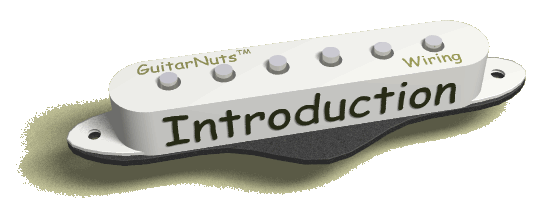
Warning! Modifying your guitar will void any manufacturer's warranty. Working on guitar wiring doesn't present much of a shock hazard -- unlike amplifiers which can easily kill you -- however, it is quite possible to totally butcher your guitar so you should only attempt these modifications if you are confident of your ability to follow diagrams and instructions and to solder well. Also, soldering presents its own hazards which you should be familiar with before making any repairs or modifications. The author(s) of these articles and host(s) and sponsor(s) of this site are not responsible in any way for damages, direct or indirect, resulting from your performing, or atttempting to perform, or being unable to perform, the modifications described here, or from any other use of this web site and the information contained herein. If you are not a responsible adult you should obtain your guardian's permission and assistance before attempting any modification.
I strongly encourage you to read the new section on electrical shock. I wrote this section after a discussion on the rec.music.makers.guitar newsgroup a few months ago made it painfully obvious that this is still a very common problem for working musicians and that many musicians are still ignorant of, or even dangerously misinformed about, the problem.
Many of the modifications herein apply specifically to Stratocaster™ type guitars but the principles, and especially the sections on theory, apply to any electric guitar. There are many things you can do to your Strat™ to change the way it sounds and improve versatility. Unless you have a very cheap guitar with lousy pickups, I would urge you to experiment with some of these inexpensive modifications before spending a lot of money to replace your pickups.
Another thing you should consider before spending a lot of money on guitar upgrades is the amplifier you are using. Even the best guitar is not going to display its potential when played through an inexpensive, tiny, solid-state practice amp with an eight inch speaker. On the other hand a really good amp can make even an inexpensive guitar with weak pickups sound much better.
It isn't absolutely necessary to understand the concepts presented in the theory section to perform these modifications -- but I think you'll find that working on your own guitar is much more enjoyable if you have a rudimentary understanding of why you're doing certain things.
Another new (January 1999) article in the theory section is the illustrated interactive lesson on five-way pickup selector switches. The lesson shows how to identify the contacts of any non-sealed selector switch and also illustrates, and gives the Fender part number for, the switch that is used in most American made Strats. This lesson requires a frame-capable browser and you must have JavaScript enabled.
The very first modification I urge you to consider is full body-cavity shielding and rewiring to reduce hum. All of the other modifications on these pages assume that you have performed this modification. Performing this modification will in no way change the tone of your guitar, other than that it may sound a bit richer because some of the faint harmonics that were previously buried in the hum will now be audible. At least once a week I get an e-mail from someone raving about how great their guitar sounds after they shielded and star-grounded it. Also, it may be my imagination, ego, coincidence, or simply wishful thinking but it seems like I'm hearing more reports of higher-end factory guitars coming with at least a shot of shielding paint in the body cavity than three years ago when I first started this crusade. Now if the manufacturer's would just adopt star-grounding I could retire this page and take up gardening or something.
|